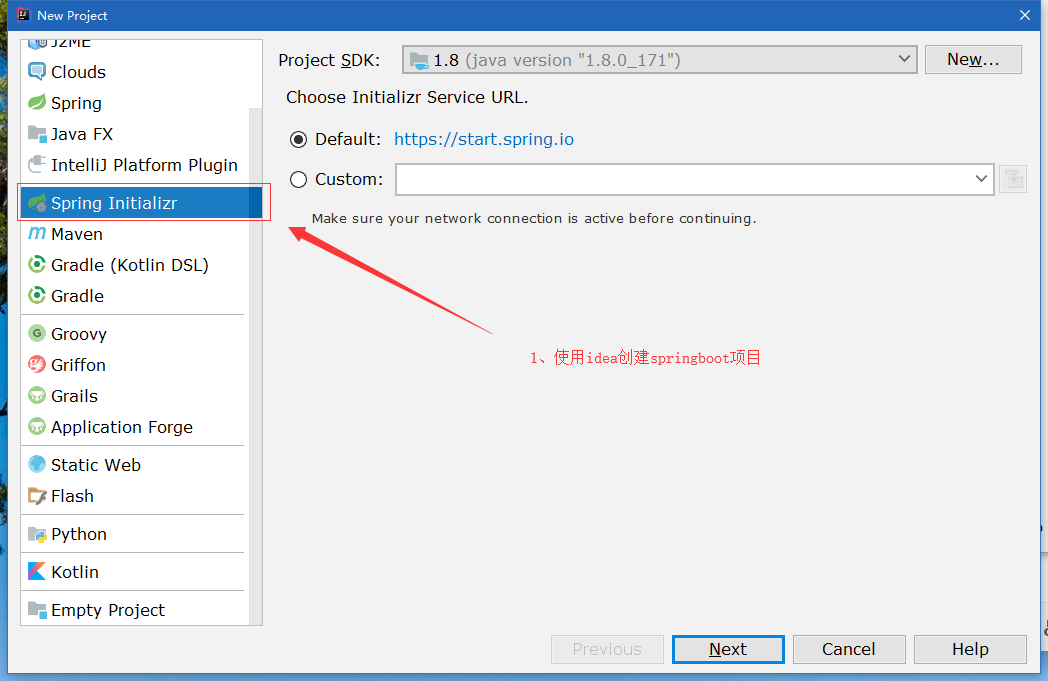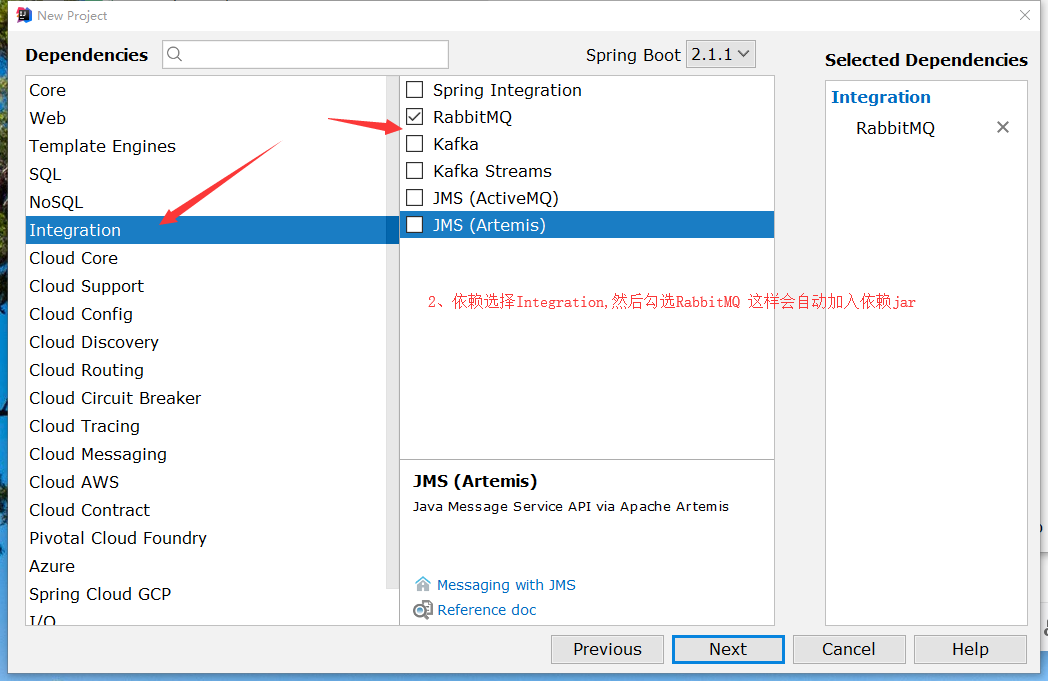准备做一个禁言自动解除的功能,立马想到了订单的超时自动解除,刚好最近在看RabbitMQ的实现,于是想用它实现,查询了相关文档发现确实可以实现,动手编写了这篇短文。
准备工作
1、Erlang安装请参考windows下安装Erlang
2、mq安装晴参考RabbitMQ安装
3、延迟消息插件安装rabbitmq_delayed_message_exchange
#插件下载地址(选择与mq版本匹配的插件版本)
http://www.rabbitmq.com/community-plugins.html
#安装命令如下(在安装目录sbin下执行如下命令)
rabbitmq-plugins enable rabbitmq_delayed_message_exchange
创建项目
我选择的是在springboot中集成RabbitMQ,配置相对简单很多。


项目创建好后,在application.properties中加入RabbitMQ参数:
#RabbitMQ config
spring.rabbitmq.host=127.0.0.1
spring.rabbitmq.port=5672
spring.rabbitmq.username=guest
spring.rabbitmq.password=guest
#Custom config
rabbitmq.exchange=test_exchange
rabbitmq.queue=test_queue_1
定义ConnectionFactory和RabbitTemplate
package com.xsh.mq.config;
import org.springframework.amqp.rabbit.connection.CachingConnectionFactory;
import org.springframework.amqp.rabbit.connection.ConnectionFactory;
import org.springframework.amqp.rabbit.core.RabbitTemplate;
import org.springframework.boot.context.properties.ConfigurationProperties;
import org.springframework.context.annotation.Bean;
import org.springframework.context.annotation.Configuration;
@Configuration
@ConfigurationProperties(prefix = "spring.rabbitmq")
public class RabbitMqConfig {
private String host;
private int port;
private String userName;
private String password;
@Bean
public ConnectionFactory connectionFactory() {
CachingConnectionFactory cachingConnectionFactory = new CachingConnectionFactory(host,port);
cachingConnectionFactory.setUsername(userName);
cachingConnectionFactory.setPassword(password);
cachingConnectionFactory.setVirtualHost("/");
cachingConnectionFactory.setPublisherConfirms(true);
return cachingConnectionFactory;
}
@Bean
public RabbitTemplate rabbitTemplate() {
RabbitTemplate rabbitTemplate = new RabbitTemplate(connectionFactory());
return rabbitTemplate;
}
public String getHost() {
return host;
}
public void setHost(String host) {
this.host = host;
}
public int getPort() {
return port;
}
public void setPort(int port) {
this.port = port;
}
public String getUserName() {
return userName;
}
public void setUserName(String userName) {
this.userName = userName;
}
public String getPassword() {
return password;
}
public void setPassword(String password) {
this.password = password;
}
}
Exchange和Queue配置
package com.xsh.mq.config;
import org.springframework.amqp.core.Binding;
import org.springframework.amqp.core.BindingBuilder;
import org.springframework.amqp.core.CustomExchange;
import org.springframework.amqp.core.Queue;
import org.springframework.beans.factory.annotation.Value;
import org.springframework.context.annotation.Bean;
import org.springframework.context.annotation.Configuration;
import java.util.HashMap;
import java.util.Map;
/**
* 配置队列
*/
@Configuration
public class QueueConfig {
@Value("${rabbitmq.exchange}")
private String exchangeName;
@Value("${rabbitmq.queue}")
private String queueName;
@Bean
public CustomExchange delayExchange() {
Map<String, Object> args = new HashMap<>();
args.put("x-delayed-type", "direct");
//使用的是CustomExchange,不是DirectExchange,另外CustomExchange的类型必须是x-delayed-message
return new CustomExchange(exchangeName, "x-delayed-message",true, false,args);
}
@Bean
public Queue queue() {
Queue queue = new Queue(queueName, true);
return queue;
}
@Bean
public Binding binding() {
return BindingBuilder.bind(queue()).to(delayExchange()).with(queueName).noargs();
}
}
消息发送
package com.xsh.mq.service;
import org.slf4j.Logger;
import org.slf4j.LoggerFactory;
import org.springframework.amqp.rabbit.core.RabbitTemplate;
import org.springframework.beans.factory.annotation.Autowired;
import org.springframework.beans.factory.annotation.Value;
import org.springframework.stereotype.Service;
@Service
public class MessageServiceImpl {
/**
* 日志
*/
private static final Logger logger = LoggerFactory.getLogger(MessageServiceImpl.class);
/**
* rabbitMQ模板
*/
@Autowired
private RabbitTemplate rabbitTemplate;
@Value("${rabbitmq.exchange}")
private String exchangeName;
/**
* 发送消息
* @param queueName 队列名称
* @param msg 消息内容
* @param delay 延迟时长 默认3秒
*/
public void sendMsg(String queueName,String msg,Integer delay) {
if(null == delay){
delay = 3000;
}
logger.info("》》》》发送消息");
Integer finalDelay = delay;
rabbitTemplate.convertAndSend(exchangeName, queueName, msg, message -> {
//必须添加header x-delay
message.getMessageProperties().setHeader("x-delay", finalDelay);
return message;
});
}
}
这里发送消息我定义了一个延迟参数,传入的延迟是多少,消息就延迟多少,方便消息延迟不一样
消费消息
package com.xsh.mq.service;
import org.slf4j.Logger;
import org.slf4j.LoggerFactory;
import org.springframework.amqp.rabbit.annotation.RabbitListener;
import org.springframework.stereotype.Component;
@Component
public class MessageReceiver {
/**
* 日志
*/
private static final Logger logger = LoggerFactory.getLogger(MessageReceiver.class);
@RabbitListener(queues = "${rabbitmq.queue}")
public void receive(String msg) {
logger.info("收到消息:{}", msg);
}
}
测试发送接收
先运行springboot项目,然后编写单元测试用例
package com.xsh.mq;
import com.xsh.mq.service.MessageServiceImpl;
import org.junit.Test;
import org.junit.runner.RunWith;
import org.springframework.beans.factory.annotation.Autowired;
import org.springframework.beans.factory.annotation.Value;
import org.springframework.boot.test.context.SpringBootTest;
import org.springframework.test.context.junit4.SpringRunner;
@RunWith(SpringRunner.class)
@SpringBootTest
public class MqApplicationTests {
@Test
public void contextLoads() {
}
@Autowired
private MessageServiceImpl messageService;
@Value("${rabbitmq.queue}")
private String queueName;
@Test
public void send() {
messageService.sendMsg(queueName, "delayMsg2", 1000 * 60 * 2);
messageService.sendMsg(queueName, "delayMsg1", 1000 * 60);
messageService.sendMsg(queueName, "delayMsg3", 1000 * 60*3);
}
}
这里我发送了三条延迟消息,控制台结果如图:

消费者接收到的消息为:

从执行结果来看,demo基本实现,RabbitMQ其他细节还有待继续看。
参考文章:Scheduling Messages with RabbitMQ